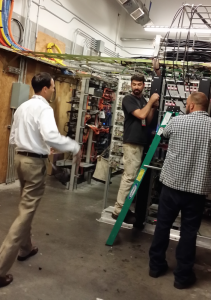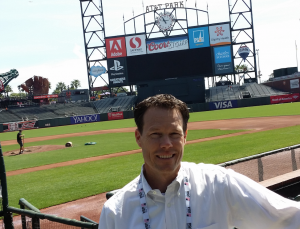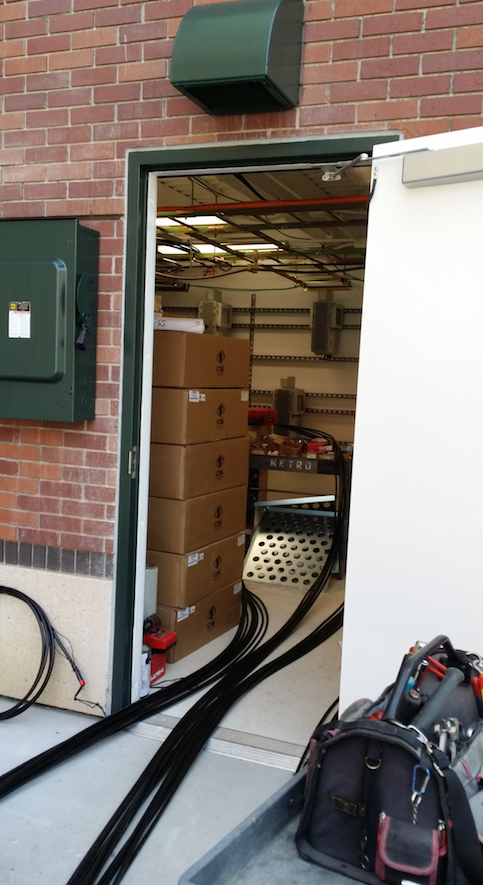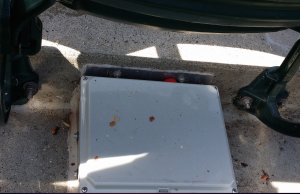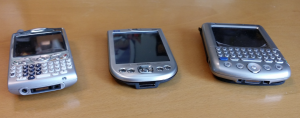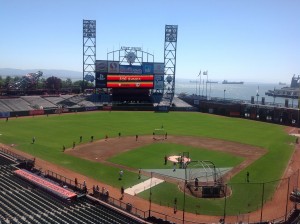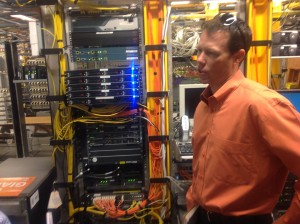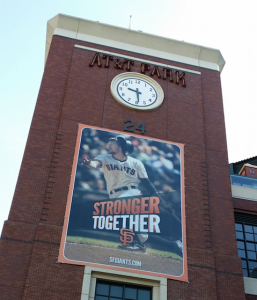
Outside AT&T Park. All photos, Paul Kapustka, Mobile Sports Report. (Click on any photo for larger image)
“It was painful,” said Bill Schlough, senior vice president and chief information officer for the Giants, during a recent in-person interview at AT&T Park. Though no big sporting events took place during the Feburary-to-March overhaul of the main AT&T distributed antenna system (DAS) head end, Schlough said during that time many of the roughly 200 to 300 employees who work at AT&T Park every day were forced to find daylight to make a call, just like the bad old days before DAS.
“We never really knew how much we rely on DAS [for internal operations], but having it down really drove it home,” said Schlough. The good news on the DAS front was that once the upgrade was complete, the Giants had a lot more space in their previously cramped head-end headquarters. According to Schlough, the new back-end equipment for AT&T’s DAS operations takes up less than 50 percent of the previous gear footprint, room that is likely to be filled with gear from yet another carrier slated to join the AT&T neutral-host DAS later this season.
Painful, but worth it.
Second major upgrade in 5 years of DAS
If you’re not familiar with a neutral DAS like the one at AT&T Park, it’s an implementation where there is one set of antennas and internal wiring, and then a “head end” where each carrier puts its cellular-specific networking gear, equipment that identifies and authorizes callers and then connects those calls or messages to fiber links back out to the Internet and beyond. As the lead provider of DAS and as the namesake sponsor of the park it makes sense that AT&T has the biggest DAS requirement on site. Verizon, which has been on the AT&T Park DAS for two years now, actually houses most of its head end gear in a separate facility nearby, and links to the AT&T Park system via fiber.Part of this year’s DAS renovations include a new room specifically being built for Sprint’s DAS equipment, a sort of re-arrange-the-house construction project that saw the ballpark wall off half its painting services workshop to make space for Sprint’s gear. During our visit we saw workers putting up the racks that will hold the Sprint head end gear, as thick fiber cables snaked in the doorway.
Additional carrier(s) would likely be placed in the same room as AT&T and Verizon, on floor space that used to hold AT&T racks before those were un-drilled from the concrete floor and new racks were installed during the February-March overhaul. According to Schlough, the DAS upgrade (which required minimal tweaks to the previously installed DAS antennas) was the second major rip-and-replace action in the 5 years the DAS has been live at AT&T Park.
DAS performance improves over time; Wi-Fi is good too
Though Wi-Fi services in stadiums gets a lot of technology headlines, in many big arenas the DAS is an equal workhorse, connecting people who either don’t know how to or prefer not to connect to Wi-Fi services. Through the first 18 games of the 2014 season, Schlough said AT&T Park was seeing average AT&T traffic loads on the DAS of 150 Megabytes on the download side (fans requesting data) and 50 MB on the upload side (fans sending data). Figures for the Wi-Fi network (which is free to all customers) for the same span of games was an average of 400 MB download, 200 MB upload per game.Schlough said performance stats for the AT&T portion of the DAS have improved vastly since the distributed antenna system was first put in.
“Just four or five years ago, 97 percent [connection rate] was actually relatively respectable,” Schlough said. Now, Schlough said network connect rates regularly hover in the “four nines” region, with a recent report showing a success rate of 99.9925 percent of all calls or texts going through.
The Wi-Fi network at AT&T Park, the first in any major sporting arena and still among the world’s most expansive, has more than 1,200 access points, many of which are now located beneath the seats. According to Schlough this coming offseason will likely represent the final phase of a stadium-wide deployment effort for the new, under-seat access points, which are installed symmetrically under the seats that are out in the open air.
Since AT&T Park doesn’t have many railings alongside the seats “in the bowl” or those in the upper decks, the under-the-seat APs were the only choice to extend Wi-Fi connectivity, he said. Though the box-like antennas do take away some under-seat storage area from approximately every 40th seat, Schlough said there haven’t been many complaints from fans about the gear.What he has seen, however, are many compliments about the network services, especially from fellow professionals in the sports IT world.
“I get friends in the business who come here and send me texts with Speedtests attached, showing how great the Wi-Fi is,” said Schlough. My own ad hoc testing before our interview (albeit during non-game hours) showed speeds of greater than 40 Mbps for Wi-Fi just outside the park near McCovey Cove, and speeds of 25+ Mbps just outside the main gate. Schlough also showed us some of the new iBeacon antennas, which are being tested at MLB parks this summer to provide near-field communication marketing opportunities, like automatically checking fans in to the official At Bat app when they pass by a beacon. It’s just another way the best-connected park in baseball seeks to continue to improve the fan experience.
According to Schlough, the connectivity at AT&T Park doesn’t hurt when it comes to ticket sales.
“People do come here more frequently, I think, because they know there will be good connectivity,” said Schlough. “There’s no compromise. I do think that’s part of why we’re currently riding the third longest sellout streak in MLB history.”
MORE PHOTOS BELOW — CLICK ON IMAGES TO SEE LARGER VERSION
Can you find the iBeacon in the bowels of AT&T Park? It’s the small grey box to the left of the other antenna.
